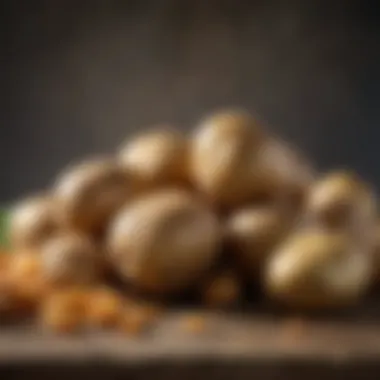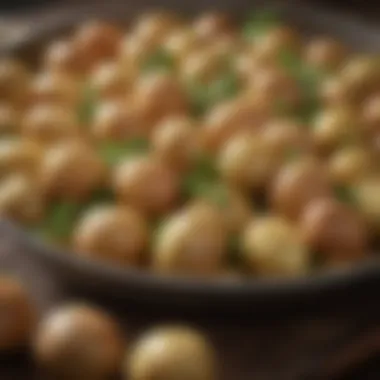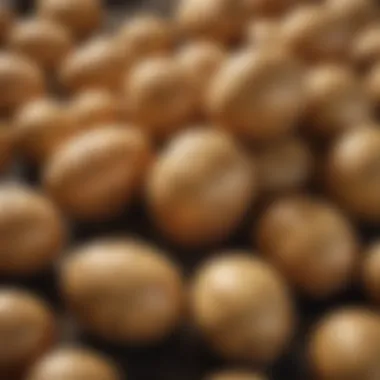The Health Implications of Potatoes: A Nutritional Perspective


Intro
Potatoes, those humble tubers often relegated to a side dish, hold a treasure trove of health benefits. The nutritional perspective of potatoes extends far beyond their starchy reputation. Despite their frequent association with weight gain and unhealthy eating habits, it's time to peel back the layers and explore the myriad ways potatoes can enhance our diets.
From vitamins to minerals, these spuds offer a significant kick of nutrients, essential for maintaining overall well-being. As we embark on this gastronomical journey, we’ll dissect their nutritional composition, investigate potential health impacts, and bust prevailing myths surrounding this versatile vegetable. By providing a detailed overview of their myriad benefits and outlining optimal preparation methods, this exploration seeks to inform and inspire food enthusiasts of all stripes, placing potatoes firmly back in the spotlight.
In the following sections, we will navigate through the intricate web of potato nutrition, and by the end, you'll appreciate how this root vegetable can harmonize with a balanced diet, offering more than just comfort food but also a powerful contribution to health.
Prelude to Potatoes
Potatoes are more than just a staple food; they have woven themselves into the fabric of culinary traditions around the globe. Understanding the significance of this tuber sets the stage for an insightful exploration of their health implications.
The humble potato is often overlooked in discussions of nutrition, yet it offers a wealth of benefits that deserve closer attention. From providing essential nutrients to being an affordable food source, there’s much to uncover. Potatoes are not only versatile in cooking but also rich in vitamins, minerals, and dietary fiber. However, contrasting opinions regarding their health benefits often lead to confusion. By starting with an examination of potatoes, we can shed light on their true nutritional profile and debunk some prevalent myths surrounding their consumption.
Historical Context
Potatoes originated in the Andean region of South America over 7,000 years ago. Early cultivation by the indigenous peoples laid down the foundation for what would become a global agricultural staple. It was not until the 16th century that Spanish explorers introduced the potato to Europe. Initially met with skepticism, potatoes gradually gained acceptance, transforming diets across countries. Today, they stand as the world’s fourth-largest food crop.
This historical journey is significant because it illustrates how potatoes adapted and integrated into various cultures. For example, in Ireland, they became a symbol of survival during the Great Famine, while in Latin America, they remain central to traditional dishes. Understanding this context allows us to appreciate the diverse ways in which potatoes contribute to different diets.
Potato Varieties
The world of potatoes is as varied as the cultures that embrace them. There are over 4,000 different varieties, ranging from the commonly known russet to the vibrant purple Peruano. Each type comes with its benefits, flavors, and unique cooking attributes.
Some prominent varieties include:
- Russet Burbank: Known for its fluffy texture, ideal for baking and frying.
- Yukon Gold: Has a creamy texture that makes it great for mashing and roasting.
- Red potatoes: Often waxy, these retain their shape well in salads.
- Purple potatoes: High in antioxidants, offering more than just a beautiful color to your plate.
Choosing the right variety is important, as it affects both the nutritional content and culinary application. When selecting potatoes, consider their usage and the cooking method. Their rich flavors and textures enhance various dishes, underscoring their versatility in both everyday meals and gourmet creations.
"The potato's journey from the mountains of Peru to dinner tables across the globe is not just a culinary tale; it reflects the adaptability of this remarkable tuber."
Whether boiled, baked, or fried, potatoes bring variety and nutrition to our plates while reminding us of their storied past.
Nutritional Profile of Potatoes
In discussing the health implications of potatoes, understanding their nutritional profile is integral. This not only sheds light on what these versatile tubers offer but also illuminates their potential role in a balanced diet. Potatoes are often dismissed as mere comfort food, yet they bring a surprising array of nutrients to the table. Analyzing the distinct components of their nutritional makeup reveals benefits that can enhance overall health and well-being. Let’s take a closer look at the key elements that compose the nutritional profile of potatoes, starting with macronutrients.
Macronutrients
Carbohydrates
Carbohydrates in potatoes are the primary source of energy. A medium-sized potato has approximately 37 grams of carbs, making it a fulfilling option for anyone needing a quick energy boost. The starch present in potatoes is not just beneficial for providing immediate energy; it also has a unique property known as resistant starch. This type of starch acts differently in the body compared to regular carbs, playing a role in gut health by serving as food for beneficial gut bacteria. This digestive advantage makes potatoes a favorable choice for those looking to maintain a healthy gut microbiome.
Proteins
While potatoes are not a chief source of protein, they do contain about 4 grams per medium potato. The protein in potatoes is relatively complete, containing all essential amino acids, though some might argue it falls short in certain categories compared to meats or legumes. They are definitely not a protein powerhouse, but they pair well with other protein sources, enhancing a meal's nutritional profile. Their subtle yet significant protein content can be an easy way to support muscle health when included as part of a well-rounded diet.
Fats


Interestingly, potatoes are naturally low in fats, with less than 0.2 grams per medium potato. The lack of fats contributes to their appeal, especially in low-fat diets. However, it’s crucial to consider how they're prepared. When fried or drowned in butter, the fat content can skyrocket. Thus, the cooking methods play a pivotal role in either enhancing or diminishing their health benefits. When prepared healthily – think baking or steaming – potatoes can be a wholesome addition, keeping the fat content minimal while still being delightful.
Micronutrients
Vitamins
Potatoes are a hidden storehouse of vitamins. They are rich in vitamin C, which boosts the immune system and promotes skin health. Potatoes also offer B vitamins, like B6 and niacin, which play key roles in energy metabolism. These vitamins have a noteworthy role in converting the food we eat into usable energy, making them especially relevant for those with active lifestyles. However, the vitamin content can be affected by how potatoes are cooked, with some methods better at retaining these precious nutrients than others.
Minerals
In terms of minerals, one of the standout features of potatoes is their potassium content. A medium potato packs about 620 mg of potassium, which is essential for heart health and blood pressure regulation. Additionally, they provide iron and magnesium, important for numerous bodily functions. While the mineral content is beneficial, it’s worth noting that their bioavailability can vary; thus, the way potatoes are consumed can impact how much of these minerals are effectively absorbed by the body.
Dietary Fiber
Dietary fiber is one more aspect where potatoes shine, particularly in the skin. A medium potato can provide approximately 2 grams of fiber, promoting digestive health. Fiber helps to regulate bowel movements and can contribute to feelings of fullness, potentially supporting weight management goals. Unlike many processed foods, potatoes offer a satisfying way to boost fiber intake, especially when consumed with the skin on.
Overall, the nutritional profile of potatoes showcases their unique potential as a healthy staple in various cuisines. The blend of macronutrients and micronutrients underscores their significance in a balanced diet.
Health Benefits of Potatoes
Delving into the health benefits of potatoes gives one the chance to appreciate this staple food’s nutritional potential. Not only are potatoes readily available, inexpensive, and easy to prepare, they can also support various facets of health when integrated mindfully into your diet. Each bite comes packed with a variety of vitamins, minerals, and fibers, offering more than just a sidekick for a meal. Hence, this section aims to shed light on the remarkable advantages that can come from consuming these tubers regularly and addressing some considerations that may come to mind.
Antioxidant Properties
Potatoes aren’t just empty calories; they are also a significant source of antioxidants. These compounds could be thought of as the body's defense system, working tirelessly to neutralize harmful free radicals. Notably, colorful varieties of potatoes, like purple and red, contain pigments known as anthocyanins and carotenoids, which might protect the body from chronic diseases.
Research shows that these antioxidants can potentially reduce inflammation and lower the risk of heart disease. It’s like getting a shield built from nature itself just by incorporating these often-overlooked veggies into your diet. Beyond just the nutritional labelling, they work silently but effectively, supporting the body from the inside. For instance, consider roasting purple potatoes drizzled with olive oil; not only does it enhance flavor, but it also brings forth those beneficial compounds.
"Incorporating antioxidant-rich foods like potatoes might minimize the risk of disease."
Heart Health
When it comes to heart health, potatoes do have their role to play, although many might not realize it at first glance. Being rich in potassium, a mineral crucial for maintaining healthy blood pressure levels, potatoes could offer a natural remedy for heart-related concerns. Potassium helps to counterbalance sodium in the body, thus potentially lowering blood pressure and reducing stress on the cardiovascular system.
Additionally, fiber present in potatoes aids in lowering cholesterol levels. You could enjoy potatoes baked or boiled, simply garnished with fresh herbs to enhance not just taste but the overall heart-friendly impact they may have. This dueling effect, alongside their low-calorie profile when prepared correctly, creates a positive outcome for heart health.
Digestive Health
The business of digestion often gets overlooked, but anyone who’s ever felt bloated or sluggish understands its importance. Potatoes contain significant amounts of dietary fiber, particularly in their skins. Fiber is well-known for aiding digestion by promoting regular bowel movements, which keeps the digestive tract running smoothly.
Moreover, resistant starch found in potatoes also acts as a prebiotic, which means it serves as food for the good bacteria in the gut, potentially fostering a healthy microbiome. A balanced gut community can affect everything from mood to immunity. To ensure you get this benefit, consider eating potatoes with the skin on and use gentle cooking methods that retain this nutrient, letting you fully capitalize on their digestive advantages.
Potential Challenges and Misconceptions
When discussing potatoes, it’s vital to address potential challenges and misconceptions that often pop up. These concerns can steer individuals away from appreciating the full value of this staple food. Understanding these elements can help demystify the role of potatoes in a balanced diet and promote informed choices.
Glycemic Index Concerns
One common concern about potatoes is their glycemic index (GI). The GI measures how quickly a carbohydrate food influences blood sugar levels. It’s been asserted that potatoes, particularly varieties like mashed or fried, have a high GI, causing spikes in blood sugar. However, the GI can vary depending on several factors:


- Preparation Method: How you cook potatoes can change their GI. Boiling, for instance, generally yields a lower GI than baking or frying. A baked potato might raise your blood sugar more than a boiled potato.
- Ripeness: The maturity of the potato can also play a role. New potatoes often have a different glycemic response compared to their starchy counterparts.
- Additives: Combining potatoes with proteins or healthy fats can also lower their overall glycemic impact. Think about a potato salad with some olive oil and eggs; it’s not just tastier but healthier, too.
So, while the glycemic response of potatoes is a legitimate concern, context matters a lot.
Impact on Weight Management
Another misconception revolves around weight management and potatoes. Many people believe that consuming potatoes will lead directly to weight gain, often due to their carbohydrate content. However, it’s crucial to contextualize this idea. Potatoes are not inherently fattening; rather, it’s how they are prepared and consumed that can make the difference. Here are some important aspects to consider:
- Satiety: Potatoes can be quite filling, which means they might help control appetite. Eating a serving can keep hunger at bay longer, assisting with portion control.
- Caloric Density: A medium potato is relatively low in calories compared to many other snacks. When prepared healthily—even boiled or baked—they can fit into a calorie-controlled diet.
- Whole versus Processed: It’s important to distinguish between whole potatoes and processed potato products. Chips and fries carry far more calories and less nutritional value than a fresh spud.
In this light, if managed properly, potatoes can be a part of weight loss regime without pushing the scale in the wrong direction.
Nutrient Loss During Cooking
A point of contention often arises around the nutrient loss during cooking. Some argue that boiling potatoes diminishes their nutritional content, particularly vitamins. While it is true some water-soluble vitamins can leach into the cooking water, one must approach this idea with nuance:
- Cooking Methods Matter: Not all cooking methods lead to significant nutrient loss. For instance, steaming can preserve more nutrients than boiling. Baking tends to retain most vitamins as well.
- Peeling: Leaving the skin on can help conserve many nutrients. Potato skins are packed with fiber, potassium, and various vitamins. If you peel your spuds, you might be losing out.
- Balanced Meal Prep: Remember, incorporating potatoes into a varied diet can enhance overall nutrient intake. If cooked properly, potatoes can maintain their health-giving properties.
Ultimately, while cooking methods can influence nutrient levels, there are savvy ways to prepare potatoes that minimize losses and maximize benefits.
Incorporating Potatoes into Your Diet
When it comes to diets, potatoes might not always get the best rap. However, they play a central role in countless cuisines around the world, bridging gaps between nutrition and flavor. Understanding how to properly incorporate potatoes can be a game-changer. Not only do they provide significant health benefits, but they also contribute a unique texture and taste that can enhance a meal's appeal.
Cooking Methods
Boiling
Boiling potatoes is a simple, often underrated method. It offers a no-fuss way to prepare them while locking in nutrients, especially if boiled with the skin on. Potatoes cooked this way can be soft and tender, making them perfect for mashing or adding to salads. The key characteristic of boiling is its approachability; it requires no special skills or elaborate equipment.
However, the downside to boiling is that it can sometimes dilute flavor. If water is not salted properly, potatoes can taste somewhat bland. Yet, when seasoned well, boiled potatoes can serve as a solid base for many dishes.
Baking
Baking potatoes provides a crispy skin and soft, fluffy interior—a combination that many find irresistible. This method amplifies the natural sweetness and earthy flavors of potatoes. Moreover, it’s a beneficial choice as it requires very little added fat, making it a healthier option in comparison to frying.
The unique feature of baking is the Maillard reaction, which creates a delicious outer crust while preserving the nutrients packed inside. With baked potatoes, one must be mindful of the potential for added toppings, which could turn a healthy dish into a calorie bomb.
Frying
Frying, whether done in oil or a healthier air fryer, turns potatoes into crispy golden nuggets that are hard to resist. While it's widely popular, frying does significantly increase calorie count and introduces trans fats, especially if done in unhealthful oils.
That said, frying can be delicious when done properly, and the unique texture it creates is something many crave. It’s wise to enjoy fried potatoes in moderation to keep health in check, but they can certainly make a meal memorable and satisfying.
Recipe Ideas
Healthy Mash
Healthy mash is more than just mashed potatoes; it’s a celebration of creamy textures with a lighter touch. By opting for low-fat milk or even vegetable broth instead of heavy cream, you can create a dish that retains its comfort food status while being easier on one’s waistline. The key characteristic of healthy mash is its adaptability. You can mix in roasted garlic, fresh herbs, or even cauliflower to elevate the dish.


One drawback is that if over-mashed, the potatoes may become gluey, losing their fluffy quality. Yet, careful attention can result a delightful side dish that pairs wonderfully with a variety of mains.
Potato Salad Variations
Potato salad often gets pigeonholed into one dull recipe, but there’s a world of possibilities out there. Various cultural nuances bring vibrant flavors through ingredients like chives, mustard, or pickles, making potato salad not just a side, but a centerpiece. The beauty of these variations is the customizability.
However, it’s essential to be judicious with dressings—too much may cloak the taste of the potatoes themselves. Opting for more wholesome options like Greek yogurt can keep it creamy without excessive calories.
Stuffed Potatoes
Stuffed potatoes can serve as a delicious, filling meal or hearty side. Depending on the fillings used, you can cater to vegetarian, meat-loving, or even pescatarian diners. The key characteristic here is versatility; whether filled with cheese, vegetables, or even beans, the sky's the limit.
If not executed well, though, they can become too heavy or fail to marry flavors properly. Careful attention to balance can enhance the freshness without overcrowding the potato.
Remember, potatoes are a blank canvas when it comes to flavor. Their versatility is unmatched, allowing numerous possibilities that can make maintaining a balanced diet both enjoyable and fulfilling.
Global Perspectives on Potato Consumption
Potatoes, a staple food for many cultures, offer a unique lens through which we can examine global dietary habits and preferences. Understanding the significance of potatoes in various cuisines not only highlights their versatility but also reflects broader social, economic, and cultural factors. In this section, we delve into the rich tapestry of potato consumption around the world and the implications it has on health and culinary practices.
Cultural Significance
In numerous societies, potatoes are deeply ingrained in cultural identity. From the Andean mountains of Peru, where the potato is celebrated with festivals honoring their ancestral roots, to Ireland, where potatoes were historically a lifeline during the Great Famine, this tuber carries with it stories of sustenance and survival.
- Symbol of Resilience: In many regions, potatoes symbolize resilience and adaptability. The ability to grow in various climates makes them a dependable crop. For instance, the indigenous peoples of the Andes cultivated thousands of potato varieties, showcasing their cultural importance.
- Tradition and Heritage: The culinary use of potatoes often links generations together. In Scandinavian countries, for example, potato-based dishes feature prominently in family gatherings, signifying warmth and togetherness.
- Celebratory Foods: Potatoes often appear in traditional celebrations. Consider the Peruvian dish Papa a la Huancaina, which is a vibrant yellow sauce made with yellow potatoes, representing the sun, and used in festivities.
These elements illustrate how potatoes are not merely food items, but instead rich in historical and emotional significance, weaving the narratives of communities together.
Regional Dishes
Diving into regional variations, potatoes take on unique characteristics, revealing much about a culture's history and climate. Here are some notable dishes that showcase potatoes on a global scale:
- Spanish Tortilla: In Spain, the humble potato becomes the star of a simple yet filling dish. Traditional Tortilla Española consists of eggs, potatoes, and onions, creating a creamy texture that reflects both rustic and modern culinary elements.
- Aloo Gobi: This beloved Indian dish combines potatoes and cauliflower with spices, showcasing how potatoes adapt to local flavors, turning them into a warm and comforting curry that is a staple at many homes.
- Poutine: Hailing from Quebec, this dish embodies the fusion of cultures. French fries are topped with cheese curds and gravy, illustrating how potatoes can evolve into a comforting meal during cold winters.
- Shepherd’s Pie: In the UK, mashed potatoes act as a blanket for minced meat in this iconic dish, offering nourishment and warmth. It represents the practical use of potatoes in traditional comfort foods.
These examples illustrate that potatoes are not just versatile but also serve as a reflection of the diverse culinary practices across the world. They carry flavors and stories that resonate deeply within their respective cultures.
"According to the FAO, potatoes are the world's fourth-largest food crop, following maize, rice, and wheat, highlighting their global significance in food security and diverse culinary capabilities."
Examining the global perspectives on potato consumption not only enriches our understanding of this versatile vegetable but also promotes an appreciation for how it has shaped dietary habits around the globe. Through this cultural lens, we can see potatoes as more than just food; they are a bridge connecting communities and histories.
Epilogue
Bringing together the pieces of the puzzle surrounding potato consumption, it becomes evident that these humble tubers pack a punch when it comes to health and nutrition. In this article, we've highlighted not just the nutritional content of potatoes, but also their potential health benefits, encompassing everything from heart health to digestive support.
Summary of Key Points
- Nutrient-Rich Profile: Potatoes are a good source of carbohydrates, dietary fiber, and essential vitamins and minerals. This makes them a versatile addition to various diets throughout the world.
- Health Benefits: The antioxidants found within potatoes contribute to enhanced overall health, offering protective properties against diseases and promoting heart health.
- Cultural Relevance: Potatoes hold significant cultural importance in many regions around the globe, serving as a staple food that ties together tradition and nourishment.
- Common Misunderstandings: We've looked at misconceptions regarding potatoes, particularly regarding their glycemic index and their role in weight management. Understanding these aspects helps in making informed dietary choices.
Future Trends in Potato Use
Looking ahead, the landscape of potato consumption is shifting. More individuals are on the hunt for healthier cooking methods and recipes that go beyond the classic fried potato. Here are some trends to watch:
- Health-Conscious Cooking: There's a growing interest in baking and steaming rather than frying. Employing techniques that preserve nutrient levels could become mainstream as more people are drawn to healthier lifestyles.
- Innovative Varieties: With advancements in agricultural practices, we might see emerging potato variants that are bred for higher nutrient density. Research into biofortified potatoes could yield varieties with increased levels of vitamins and minerals.
- Sustainable Practices: As climate change continues to shape agricultural strategies, sustainable potato farming methods are likely to gain traction, enabling nutrient conservation while fulfilling food requirements.
- Fusion Dishes: Culinary creativity means a rise in potato-based fusion dishes that blend different cultural elements, making potatoes appealing to a broader audience of food lovers.
Overall, potatoes are poised to continue their reign as a vital food source, adapting with the changing times and preferences, while still serving their foundational role in numerous cuisines across the world. This adaptability ensures that potatoes will be around to nurture future generations, maintaining their status as a beloved staple in both health-focused diets and cultural experiences.







